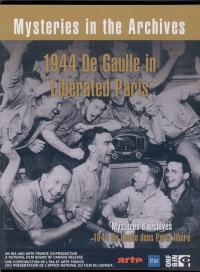| ________________
CM . . .
. Volume XVIII Number 13. . . .November 25, 2011 
 |
Mysteries in the Archives: 1944 De Gaulle in Liberated Paris.
Serge Viallet (Director). Florence Fanelli (Producer).
Montreal, PQ: National Film Board of Canada, 2007.
26 min., DVD, $99.95.
Order Number: 153B 9909 277.
Grades 11 and up / Ages 16 and up.
Review by Joanne Peters.
**½ /4
|
| |
|

In August 26, 1944, the city of Paris is jubilant. General Charles de Gaulle strides purposefully down the Champs Elysées, a tall, commanding, heroic figure. His destination is Paris's Notre Dame Cathedral where a celebratory Mass is to be held. At the Place de la Concorde, a car arrives to take the General to the square. De Gaulle leaves the car, enters the cathedral, and while there is a commotion in the crowd, he seems nonplused, even unaware. Where is the gunman, and who is he? A Nazi sniper? Or, just some crazed gunman with another target in mind? A mystery, of sorts.
Several productions in the "Mysteries in the Archives" series focus on assassinations. Unlike the 1934 assassination of King Alexander of Yugoslavia, or the 1963 assassination of President John F. Kennedy, this attempt (if, in fact, it was an assassination attempt) was unsuccessful. But, as a public relations gesture, the 1944 film coverage of de Gaulle was wildly successful, celebrating the General as both a military and a political leader. Certainly, the footage of joyous Parisians made for great newsreel coverage of the triumph of the Allied forces. There is a vignette of an American GI speaking a few sentences of French, and numerous images of young French women kissing American servicemen (genuine or staged? An opportunity created by the presence of a camera filming the scene, or just a spontaneous outpouring of gratitude, captured on film forever?)
Interestingly, the film footage, complete with the sounds of gunfire and the subsequent images of crowd chaos, "disappeared" for decades. The suggestion is that the footage was deliberately "lost" (or censored) so as to downplay the shooting incident completely and to maintain the hugely positive attitude generated by de Gaulle's triumphal walk. And, it is also indicated that sound cameras were uncommon amongst French photo-journalists; Gaston Madroux (who worked for Paramount, an American company), was one of a select few who owned one, and it appears that his connection with Paramount resulted in his filming scenes which suggested closer ties between France and the United States than might actually have been the case.
A great deal of speculation is raised in this production, and plenty of questions remain unanswered. One thing is clear, though: the viewer is left with the certainty that media is never "unmediated," and that bias of some sort is always present, particularly in the filming of political events. As with other productions in the "Mysteries in the Archives" series, 1944 – de Gaulle in Liberated Paris might find some use by senior high classes (Grades 11 and 12) studying journalism or modern world history. However, it's worthwhile to preview this item to see if the content will generate sufficient use to make it a worthwhile acquisition.
Recommended with reservations.
Joanne Peters, a recently retired high school teacher-librarian, lives in Winnipeg, MB.

To comment
on this title or this review, send mail to cm@umanitoba.ca.
Copyright © the Manitoba Library Association. Reproduction for personal
use is permitted only if this copyright notice is maintained. Any
other reproduction is prohibited without permission.
NEXT REVIEW |
TABLE OF CONTENTS FOR THIS ISSUE
- November 25, 2011.
AUTHORS |
TITLES |
MEDIA REVIEWS |
PROFILES |
BACK ISSUES |
SEARCH |
CMARCHIVE |
HOME |
